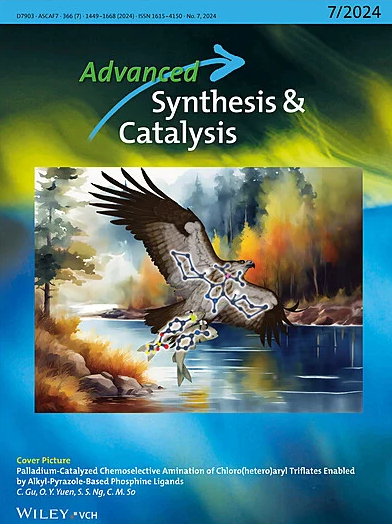温和条件下Pd@POP-1催化锅炉烟气CO 2可持续合成喹唑啉酮
IF 4.4
2区 化学
Q2 CHEMISTRY, APPLIED
引用次数: 0
摘要
通过咪唑和三嗪离子盐与二乙烯基苯的共聚,将钯(Pd)纳米粒子嵌入富氮多孔有机聚合物(POP)中,成功合成了催化剂 Pd@POP-1。这种催化剂在三嗪环内具有独特的亚胺(-C=N)结构和多个偶联亚胺基团,可显著提高二氧化碳的吸附效率,并表现出卓越的催化性能。在常压和低温条件下,即使存在二氧化硫(高达 428 mg/m³)和二氧化氮(高达 221 mg/m³),Pd@POP-1 也能有效地将低浓度 CO2(小于 15 vol.%)转化为喹唑啉酮,并获得高产率。值得注意的是,Pd@POP-1 还能有效地将锅炉烟气中含有 10 Vol.% CO2 的 CO2 转化为喹唑啉酮,且收率令人满意。这种方法以实际烟气代替光气作为碳源,不仅为喹唑啉酮的生产提供了一种生态友好型替代方法,而且也是烟气中二氧化碳资源化利用的一种有前途的策略。本文章由计算机程序翻译,如有差异,请以英文原文为准。
Sustainable Synthesis of Quinazolinones through Boiler Flue Gas CO₂ Utilization via Pd@POP-1 Catalyst under Mild Conditions
A catalyst, Pd@POP-1, has been successfully synthesized by embedding palladium (Pd) nanoparticles into a nitrogen-rich porous organic polymer (POP) through the copolymerization of imidazole and triazine ionic salts with divinylbenzene. This catalyst features a unique imine (-C=N) structure within the triazine ring and multiple coupled imine groups, which significantly enhances CO2 adsorption efficiency and exhibits remarkable catalytic performance. At ambient pressure and mild temperatures, Pd@POP-1 effectively converts low-concentration CO2 (less than 15 vol.%) into quinazolinones, even in the presence of SO2 (up to 428 mg/m³) and NO2 (up to 221 mg/m³), achieving high yields. Remarkably, Pd@POP-1 also efficiently transforms CO2 from boiler flue gas, which contains 10 vol.% CO2, into quinazolinones with satisfactory yields. This approach not only provides an eco-friendly alternative for quinazolinone production by replacing phosgene with actual flue gas as a carbon source but also represents a promising strategy for the resource utilization of CO2 in flue gas.
求助全文
通过发布文献求助,成功后即可免费获取论文全文。
去求助
来源期刊

Advanced Synthesis & Catalysis
化学-应用化学
CiteScore
9.40
自引率
7.40%
发文量
447
审稿时长
1.8 months
期刊介绍:
Advanced Synthesis & Catalysis (ASC) is the leading primary journal in organic, organometallic, and applied chemistry.
The high impact of ASC can be attributed to the unique focus of the journal, which publishes exciting new results from academic and industrial labs on efficient, practical, and environmentally friendly organic synthesis. While homogeneous, heterogeneous, organic, and enzyme catalysis are key technologies to achieve green synthesis, significant contributions to the same goal by synthesis design, reaction techniques, flow chemistry, and continuous processing, multiphase catalysis, green solvents, catalyst immobilization, and recycling, separation science, and process development are also featured in ASC. The Aims and Scope can be found in the Notice to Authors or on the first page of the table of contents in every issue.
 求助内容:
求助内容: 应助结果提醒方式:
应助结果提醒方式:


